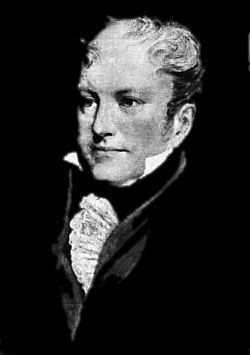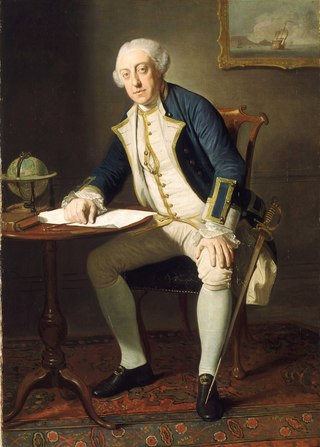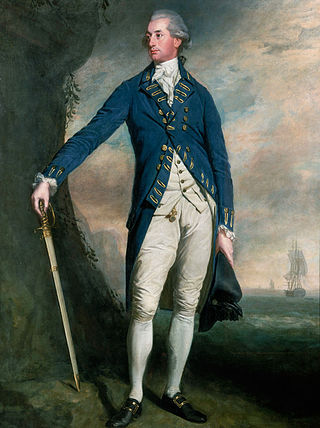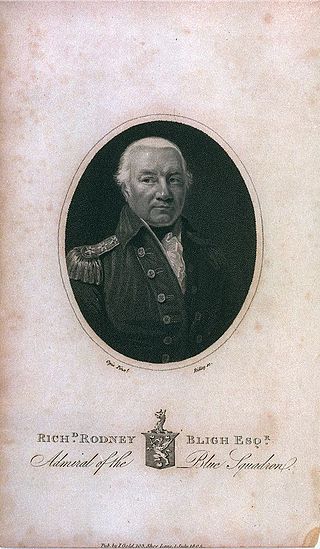
Admiral of the Blue Edward Boscawen, PC was a British admiral in the Royal Navy and Member of Parliament for the borough of Truro, Cornwall, England. He is known principally for his various naval commands during the 18th century and the engagements that he won, including the siege of Louisburg in 1758 and Battle of Lagos in 1759. He is also remembered as the officer who signed the warrant authorising the execution of Admiral John Byng in 1757, for failing to engage the enemy at the Battle of Minorca (1756). In his political role, he served as a Member of Parliament for Truro from 1742 until his death although due to almost constant naval employment he seems not to have been particularly active. He also served as one of the Lords Commissioners of the Admiralty on the Board of Admiralty from 1751 and as a member of the Privy Council from 1758 until his death in 1761.

Charles Stirling was a vice-admiral in the British Royal Navy.

Admiral Philip Affleck was an admiral in the Royal Navy. He was the younger brother of Sir Edmund Affleck. Affleck held various commands throughout the latter half of the 18th Century, most notably as commander-in-chief of the Jamaica Station and as a Lord of the Board of Admiralty. Early in his career he fought at the Siege of Louisbourg where he was promoted commander after carrying out a successful cutting-out mission. He was promoted to post-captain a year later after impressing Admiral Edward Boscawen during the Battle of Lagos. Later in his career he joined Admiral Sir George Rodney in the West Indies and took part in the capture of Sint Eustatius. Between 1790 and 1792 he held the position of commander-in-chief of the Jamaica Station and between 1793 and 1796 he held his position as a Lord of the Board of Admiralty. Although his career was marked with long periods of inaction and unemployment Admiral Affleck was known as a good officer and was well respected by his peers.

Admiral Sir George Montagu was a Royal Navy officer, the second son of Admiral John Montagu, and the brother of Captain James Montagu and Lieutenant-Colonel Edward Montagu.

Charles Holmes was a Rear Admiral in the British Navy during the Seven Years' War, and was Wolfe's third-in-command during the capture of Quebec in 1759. He is also known for leading a British squadron up the River Ems in 1758, leading directly to the Capture of Emden.

Admiral of the Fleet Sir Chaloner Ogle KB was a Royal Navy officer and politician. After serving as a junior officer during the Nine Years' War, a ship he was commanding was captured by three French ships off Ostend in July 1706 in an action during the War of the Spanish Succession. Ogle was given command of the fourth-rate HMS Swallow and saw action against the pirate fleet of Bartholomew Roberts in the Battle of Cape Lopez in February 1722. The action was to prove a turning point in the war against the pirates and many consider the death of Roberts to mark the end of the Golden Age of Piracy.

Vice-Admiral Sir Joshua Rowley, 1st Baronet was a Royal Navy officer who was the fourth son of Admiral Sir William Rowley. Sir Joshua was from an ancient English family, originating in Staffordshire (England) and was born on 1 May 1734. Rowley served with distinction in a number of battles throughout his career and was highly praised by his contemporaries. Unfortunately whilst his career was often active he did not have the opportunity to command any significant engagements and always followed rather than led. His achievements have therefore been eclipsed by his contemporaries such as Keppel, Hawke, Howe and Rodney. Rowley however remains one of the stalwart commanders of the wooden walls that kept Britain safe for so long.

Admiral Sir Robert Waller Otway, 1st Baronet, GCB was a senior Royal Navy officer of the early nineteenth century who served extensively as a sea captain during the Napoleonic War and later supported the Brazilian cause during the Brazilian War of Independence. During his long service, Otway saw action across Europe and in North America and was rewarded in his retirement with a knighthood, baronetcy, and position as a courtier within the Royal Household.

Admiral Richard Lestock was an officer in the Royal Navy, eventually rising to the rank of Admiral. He fought in a number of battles, and was a controversial figure, most remembered for his part in the defeat at the Battle of Toulon, and the subsequent court-martial.

Sir William Whetstone was an officer of the Royal Navy in the later 17th and early eighteenth century. He eventually rose to the rank of rear admiral, having spent his career serving with several distinguished figures.

Admiral Sir Richard Rodney Bligh, GCB was an officer of the Royal Navy. He saw service during the American War of Independence, as well as the French Revolutionary and Napoleonic Wars, eventually rising to the rank of admiral. He served as Commander-in-Chief, Jamaica Station and Commander-in-Chief, Leith.
Admiral Sir Lawrence William Halsted GCB was an officer of the Royal Navy who served during the American War of Independence and the French Revolutionary and Napoleonic Wars.

Admiral Sir Charles Rowley was a Royal Navy officer who went on to be Commander-in-Chief, Portsmouth.
Vice-Admiral James Gambier (1723–1789) was a Royal Navy officer who went on to be Commander-in-Chief, North American Station. The historian David Syrett presented a study of Gambier, which presented him as corrupt and largely disliked by his fellow officers.

Sir Arthur Farquhar KCH, CB, RSO was an officer of the British Royal Navy. He served during the French Revolutionary and Napoleonic Wars.
Admiral Matthew Barton was an officer of the Royal Navy. He rose to the rank of admiral during a long and distinguished career, in which he served in the War of Jenkins' Ear, the War of the Austrian Succession and the Seven Years' War. He fought at several major battles, and commanded a number of amphibious assaults off the French coast and in the West Indies. Though he lived until 1795 his health was broken after service in the tropics, and he never served at sea again after 1763.

Rear-Admiral John Bligh CB was an officer in the Royal Navy who served during the American War of Independence and the French Revolutionary and Napoleonic Wars.

Vice-Admiral Charles Stewart was an officer of the Royal Navy who saw service during the Nine Years' War, and the Wars of the Spanish Succession, Quadruple Alliance and Austrian Succession. He embarked on a political career, and was a Member of Parliament for the Parliaments of Ireland and Great Britain.

Vice-Admiral Thomas Cotes was a Royal Navy officer who became Commander-in-Chief of the Jamaica Station.
Vice-Admiral Sir Charles Hardy, also known as Sir Charles Hardy the Elder, was a Royal Navy officer of the eighteenth century. Hardy entered the Royal Navy in 1695, joining his cousin Captain Thomas Hardy's ship HMS Pendennis. Promoted to lieutenant in 1701, he served in several ships of the line before being promoted to commander in 1705. Hardy commanded sloops in the English Channel, Mediterranean and North Seas, before taking command of HMS Dunwich in 1709, in which he was promoted to post captain. Hardy subsequently served for a year at Jamaica before commanding two ships during the Great Northern War between 1718 and 1720. Having changed commands several times, in 1727 he fought at the thirteenth siege of Gibraltar in HMS Kent.

















